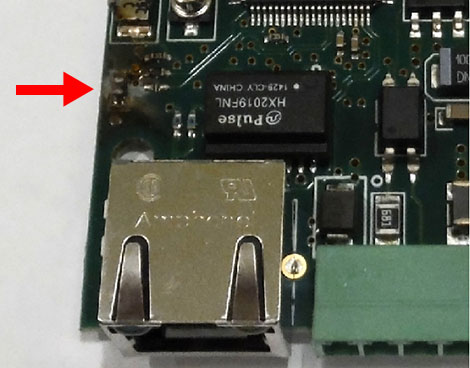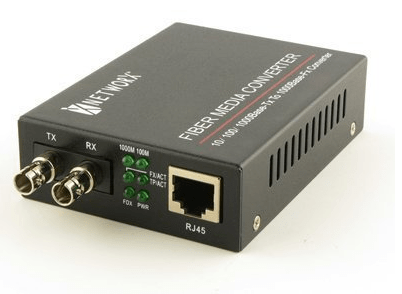Learn how to reduce the risk of over-voltage conditions, such as lightning damage to ControlByWeb products. This briefly describes where lightning protection is most needed, how it works, and suggests ways to reduce risk of lightning damage.
A lightning strike contains an incredible amount of energy which can damage or destroy any electrical device. Although there isn’t any way to protect equipment from 100% of all damaging lightning strikes there are good installation practices that can reduce the risk of lightning damage to ControlByWeb® products. This document briefly describes where lightning protection is most needed, how it works, and suggests ways to reduce risk of lightning damage.
Brief Note: Most users use a surge protector for the power supply; however, many fail to protect a device from network wiring over-voltage. The following are protective guidelines and principles used to protect from over-voltages through network cabling.
ControlByWeb Product Electrostatic Ratings
ControlByWeb products are designed for use in industrial environments where electrical transients, electrostatic discharge and other hazards occur. In general all of the signals exposed on the screw terminal connectors and the Ethernet connections are protected with internal ESD and over voltage suppression devices. During CE testing, ControlByWeb products must survive the IEC 61000-4-2 (2008) electrostatic discharge immunity tests. This test applies ten 4kV direct discharges of both positive and negative polarities directly to the connector pins and ten 8kV air discharges of both polarities to the seams and openings in the enclosure. These tests simulate a personnel discharge directly to the device.
Built-In Single-State Protection Circuits
The internal protection circuits in our products include steering diodes, transient voltage suppressors (TVS) and other circuitry. Transient voltage suppressors limit voltage spikes to tolerable levels by clamping action. A suppressor that clamps, begins by conducting when its threshold voltage is exceeded, then restores to a non-conducting state when the voltage drops below the threshold. These circuits are generally classified as “single-stage” transient voltage protection.
Two-Stage Protection Circuits
As seen in the photograph a lightning discharge has overwhelmed the transient voltage suppressor components. Two-stage or other more advanced protection circuits are needed for high-energy, lightning-induced discharges. With two-stage protection, devices such as gas-filled tubes and spark gaps are employed to absorb the discharge and protect the fast acting second-stage circuits. Unfortunately, two-stage circuits are more complex and expensive, a cost that not all customers are willing to bear, especially since many installations are not exposed to potential lightning damage. High-energy discharges, such as the one that damaged the device in the photo can damage any information technology device.

Direct and Secondary Lightning Strike Vulnerabilities
A device can be damaged from both direct or secondary lightning strikes. With a secondary lightning strike, the discharge most commonly occurs to a power line, fence or a metal building shell. The discharge can follow a convoluted path through the buildings wiring, IT network and then through a device such as a ControlByWeb device to ground. The potential for damage increases if the Ethernet network is routed between buildings. In this case lightning may strike a building or a power line connected to the building. With sufficient energy the building, wiring and everything attached is energized with a severe voltage transient. The voltage transient can flow through the Ethernet wiring to an outbuilding and find a path to ground through any device with an Ethernet connection and a power (ground) connection. Devices such as the ControlByWeb Analog module with grounded input connections are especially vulnerable.
Weather Stations
Applications such as a weather station using the X-320M are a challenge where the sensors are installed on a tower and are especially vulnerable to lightning. In this case make certain the tower itself is bonded to a copper ground rod, driven deep in the earth. Install a shielded lightning surge protection device as explained below with the ground screw securely bonded to the tower ground.
Best Over-Voltage Protection
The best protection scheme is made at the system level. Examine your wiring and IT system for sources of potential assault. A common exposure is from a modem connected to a telephone line or broadband cable, or a wireless device with a rooftop antenna. Wired Ethernet connections between buildings are especially vulnerable. It is not necessary to protect every device on the Ethernet network – just the points of entry. For wired CAT-5 connections consider installing an in-line surge protector such as the recommended device shown below.
Shielded Lightning Protector
For wired CAT-5 connections consider installing an in-line surge protector such as the recommended device shown (L-COM). If your network employs Power-over-Ethernet (PoE), make certain the protection device is compatible with the dual voltages used by PoE. Select a device with a metal enclosure and a heavy ground terminal or earthing lead.

The L-COM (www.l-com.com) Model HGLN-CAT5-2 is a shielded CAT5 lightning protector which provides lightning and surge protection for CAT5 data applications. The unit is compatible with industry-standard IEEE 802.3af Power-over-Ethernet devices and 10/100 Ethernet networks.
Give careful consideration to where the protection device is installed. The goal is to place the exposed devices (modems, other buildings, long wires etc.) on one port, and the devices to be protected (Ethernet switches, computers, servers, internal network) on the other. A suitable ground connection MUST be made to the surge protector for it to function correctly. The surge protector clamps the voltages on the data lines and diverts the surge to the ground wire. The ground wire must provide a low resistance, low inductance path to ground. Inductance is the intrinsic resistance wires have to fast changing voltages (such as lightning.)
- Install the surge protector at the point where the Ethernet wiring enters the building.
- Connect a ground wire between the ground screw of the surge protector to a ground rod driven into the soil, the metal shell of the building, or the metal box of an electrical outlet if nothing else is available.
- Keep the ground wire short.
- Use heavy gauge ground wire, 12 or 10 AWG minimum.
Fiber Media Converter
For exposed applications, connections between buildings or long Ethernet wiring connections, consider employing a fiber over Ethernet link. Fiberoptic cables are immune to everything but a direct hot lightning strike to the cable. The media converters require no programming and are available from electrical wholesalers for less than $200. Duplex (2-fiber) multi-mode fiber optic cable is available today for almost the same cost as CAT-5 cable. Pre-terminated fiber cables are readily available. For long runs or where the fiber cable must be pulled through conduit, many electricians and IT personnel can install the fiberoptic connectors.

